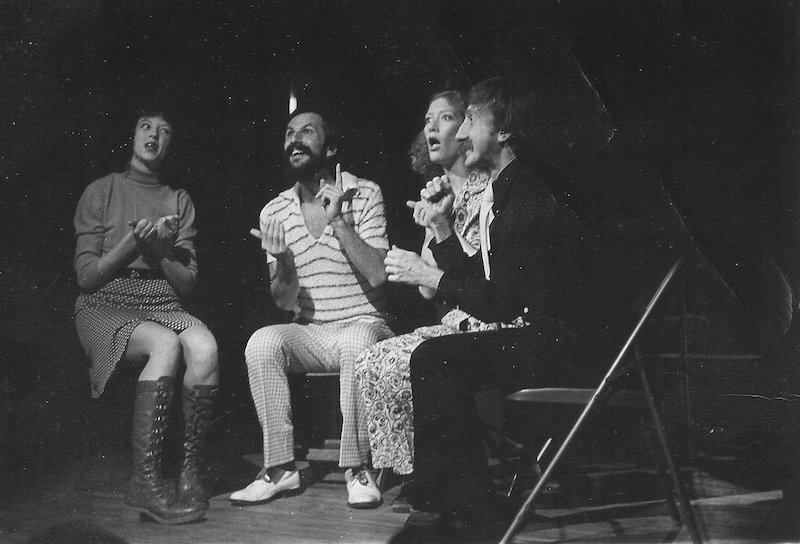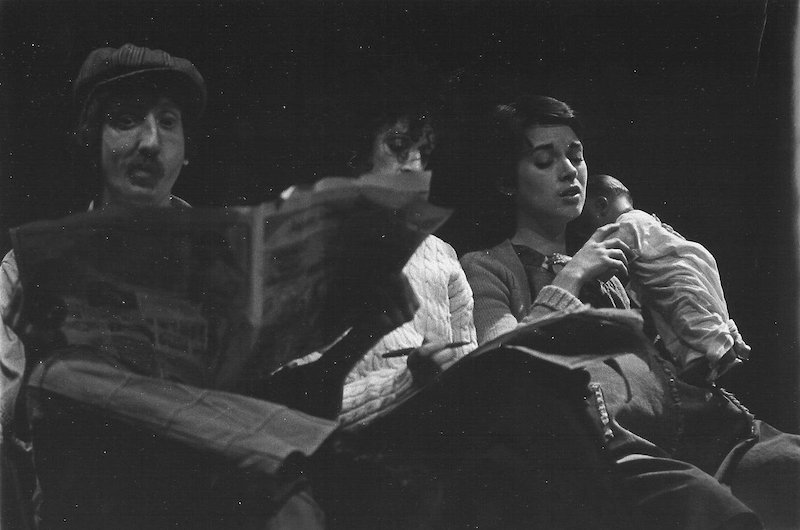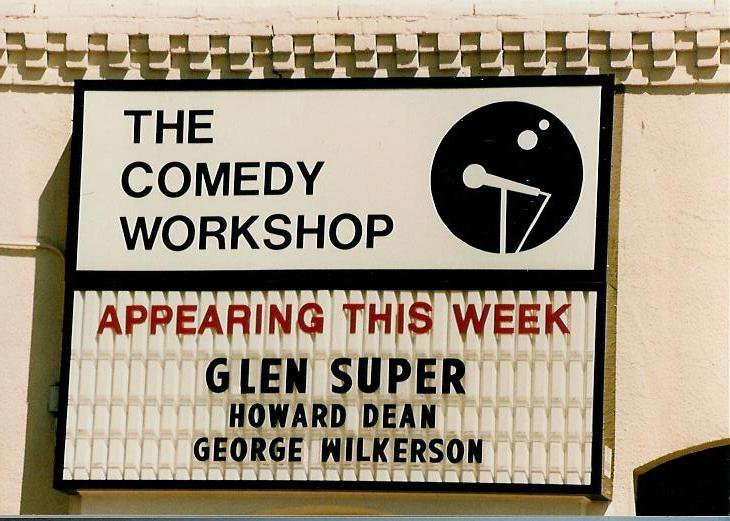In Memoriam: George Wilkerson
Remembering Esther's Follies' first sketch-writing superstar
By Robert Faires, 3:05PM, Wed. Jun. 17, 2020
If you had the good fortune to be at Esther's Follies in its early years – and that's asking a lot since we're talking 40 years ago – then much of the chuckling, chortling, and guffawing you did was thanks to George Wilkerson. He wrote 100 sketches for the group back then – many of which kept being revived because they were so expertly crafted at provoking laughs.
Wilkerson passed away on May 12 at the age of 78. The cause was cancer.

The son of Pius and Adele Wilkerson, George arrived on the scene in 1942, while his parents were still in Brooklyn, and then he bounced around the state of New York for the first quarter-century of his life: grade school in Long Island, high school in Oceanside, undergraduate studies in Geneseo, graduate school in Syracuse. In time, he bounced into Austin, where he stayed for 25 years, then it was back to New York – Schenectady this time – then finally to Nashville, where he lived for a dozen years.
Wherever he went, George was writing. That became the foundation of his life, giving him impressive dual careers in education and industry, in the former as a teacher of composition, literature, technical writing, and legal writing, and as co-author of the textbook Analyzing Short Stories; in the latter as a writer and editor of technical materials, a marketing specialist, a website developer, and a coordinator of contract proposals and other documentation. Wilkerson started at Austin Community College in the Seventies as the founding Dean of Instruction, and while there in the Eighties, he developed the first online composition course in Texas. He continued to teach online at multiple schools for 30 more years. His corporate gigs included stints with Dell Computer and Radian International in Austin, General Electric Corporate R&D and the Knolls Atomic Power Laboratory in New York, and Shell Petroleum in Nigeria. When he was working as a private contractor, his dozens of clients ranged from the U.S. Coast Guard and the U.S. Army Corps of Engineers to IBM and Lockheed-Martin. By the way, when he hung out his shingle as a freelance writer and editor on the web, Wilkerson could be found at drwrite.com.
So yes, writing was his life.
Still, in his 50-plus years of writing professionally, the three that Wilkerson spent with Esther's stand out. When the Follies debuted, shows changed weekly, meaning there was a constant need for new material, and Wilkerson fed that beast at a furious pace. What was remarkable was how consistently he produced skits that were tightly written and reliable in terms of concept, establishing characters, setting up the laughs, and then delivering them. He was a graduate of the old school of sketch comedy, which was why his scripts succeeded over and over and were brought back again and again. But the people who can best speak to that time and what George brought to it were the people who were there with him then. And a few of them have been kind enough to contribute their personal memories of George Wilkerson.

Shannon Sedwick: George Wilkerson goes back to the earliest days of the Follies in the late Seventies, what some people call our “golden days.” Our cast numbered 30 actors and actresses, and there were factions that swirled and fought and loved fiercely, and we changed the show weekly. George was the steady fulcrum at the center, always getting along with everybody and faithfully bringing in new skits every week. He was in love with writing, and it was a joy to him to create wordplay, with his fountain of comedy never seeming to run dry. Some of his classics were rhythmic dances of words, like “Bridge Night,” where two couples start with the words “Bridge Night!” then have short exchanges that evolve into double entendres, obvious spouse swapping, spats, and making up. “I Am Texas” was staged with the actors sticking their heads out of a giant map of Texas, each head for one of the main cities, and telling jokes about themselves. “Supermarket” was two socialites meeting at the grocery store, one-upping each other, with the final topper being, “I guess you heard I saw Jesus last night? Well, I did, downtown at the Hyatt Regency. I asked him up to my room for a little drink, but you know he doesn’t drink? The nicest man, though. He just kept filling my glass with wine from God knows where!”
Linda Wetherby: I did not know George outside of the Follies, but what I do recall is that he was a sweet soul and was relaxed and happy on the job. His sketches were classic Follies fare, and all were evergreen so we were able to adapt them over and over. His trademark skits were cleverly worded with rapid-fire rhythms. He was generous with his material and had no problem with performers riffing on his characters. An example is "Supermarket" that Shannon and I performed many a time. The premise was two snobby women bump into each other at the grocery store and try to one-up each other while inquiring about what the other had been up to. It got more and more far-fetched, as one says, "We bought Disneyland for the kids," and the final one-up was always, "We saw Jesus. Such a nice man." I must say though that it really never got funnier than the original. That skit didn't require anything but two women onstage, no set required, so it was very useful to put between bigger numbers to give the other actors time to get ready for the next number. We wore that bit out!
Terry Galloway: My favorite skit was one that George wrote and performed in with me and the late, great William Dente (aka Dame Della Diva). It was “Solitaire.” A surreal bit of three people playing that game of cards – well, two playing. The third (me) was more interested in chomping apples. George, William, and I rehearsed and rehearsed that piece because timing was everything – those two had to slap the cards on the table in tandem, and I had to gnaw through an apple in exactly the same rhythm. We had a hilarious time rehearsing – it's always fun to work with people who aim for the same kind of perfection you're aiming for, and boy, the three of us were in it together! It was thrilling for us to work on the timing of that piece, to get it right, to make the absurd make sense somehow simply through our performances. That was a driving energy in George (and William, for that matter). To get it right. To make it thrilling. To make it fun. To add that flicker of nonsense to the "real." His skits were, yeah, a little old school in that they left little room for improvisation – his language was that exact. But that exactness often led to escalating returns – we'd get better and better, faster and faster, funnier and funnier.
De Lewellen: George and I were pretty good friends, and I always enjoyed being in his bits. The first skit I was ever in at Esther’s was a Wilkerson script, “Bridge Night.” Like “Solitaire,” the script that Terry described, it was all about timing. It was a challenge to get laughs out of all that structure. Then Shannon and I did one of his scripts called “At Home in the Home,” about two elderly ladies remarking on their neglected existence in the nursing home. It was bittersweet and always seemed to strike a chord with the audience. George’s pieces were well-written and fun to perform, and George was easy to work with and fun to be around. This old world has lost a funny friend.
Shannon Sedwick: George tried his hand at political writing with “The Red Sea Story,” featuring Golda Meir and dancing Arabs and diplomats, but his main love was the common everyday thread of life. We had a weekly soap opera called “The Boyles” that always had a cliffhanger based on banality. After our cast split into two factions, and half left to open their own space up the street where Joe Sears and Jaston Williams had a theatre, we had to all pitch in to create a fresh show, and George came through with his usual brilliance, never confrontational, just happy to see his work being performed and applauded. He did spin off some of his work to do a full show of his own material, calling it River City Revue and producing it at Liberty Lunch using the Esther’s actors. I am grateful to George for giving us our first example of professionalism and teaching us the simple pleasure of words.
Terry Galloway: I saw George last a couple of years ago when I was performing one of my solo shows in Nashville. We had lunch together and talked about, oh, everything – his memoir, mine, alternate identities, his family, his health, new ideas for skits. We laughed so loudly and so long. Lunch left us feeling pleased with ourselves, that we had so intensely inhabited a creative space in Austin that we had helped carve out. I told him how much I had loved performing in his skits, remembering aloud others like “16th Century Soap” and “Supermarket,” ones we'd done at Esther’s and at River City Revue, ones he’d given to the Mickee Faust Club [Galloway’s comedy troupe in Tallahassee, Fla.] to perform decades later. He was pleased to know that those older skits of his elicited exactly the same reactions in audiences 30something years after he'd written them. We parted with hugs and tears and, of course, more laughter. George was a remarkable writer, a funny, tender, and loving guy. A true and valued friend of my youth.
Kerry Awn: I believe I drew a portrait of George for a poster before I ever met him, which is not that unusual but getting to know him was the unusual part. George was one of the people that I would classify as too smart for their own good. By that I mean he was smarter than the average bear and didn't always fit in with the ways of the world so it made only sense that he was a prolific writer. He created his own world filled with his own characters.
He was a member of Esther's Follies way before I was and seemed part of that theatre/intellectual crowd that hung around there. I came more from a rock & roll crowd, but he's one of the people that took a liking to me and started putting me in sketches. He said it was easy to write for me as I could make his words funny. He left Esther’s shortly after I joined, but we were soon reunited when the Comedy Workshop opened and we were both trying to be stand-up comics. Once again, he was the one offering up smart jokes, and I meanwhile found my spot in the gutter.
Over the years and decades, I lost track of him, but we found each other again on Facebook and he contacted me to do some artwork for one of the publications he wrote short stories for. He was still writing, and I had gradually eased my way back into my first love, art. I got to see him again in person when I went to Nashville in 2018 and he was driving for Uber. He was my personal valet in Nashville and regaled me with stories about that city whilst he squired me around town. I went to see him again at his home in Nashville last year after learning he was dancing with the Big C, and although frail and using a cane, he roared back to life during our visit and once again entertained and taught me.
I guess the main thing I take away from being his friend over a span of several decades was to follow your own path, be your own man, and believe in yourself. He believed in me, so what choice did I have than to take his advice? He was a wise and gentle soul who led with humor and love as his calling card. We can all learn from that. Sail on silver boy, and I'll see you in the green room.
Mark Kishego: I met Wilkerson on Sixth Street after the afternoon rehearsal at the Follies in the spring of 1981. We acknowledged each other, but I did not see him again until my stint with the Follies was long over and I worked for Austin American-Statesman. When Shannon, who was placing an ad for the week's show in the paper, told me about Houston's Comedy Workshop coming to town and setting up a venue. I immediately made myself useful, and [Workshop owner] Paul Menzel asked if I would handle the thankless job of running local talent night. This is when I ran into Wilkerson again as he was [starting] to explore stand-up comedy, and it started a friendship which lasted until his death. I realized that I was with someone who had some gravitas – a Ph.D. in English even – and upped my conversation about funny. He, along with Steve Saugey, who I also met at the Follies, knew funny, and they claimed I did also.
George began his stand-up without audition and blossomed into a sort of a solo variety act with song parodies, social commentary, and witty wordplay, and as an emcee/opener he never lost control of the show. Wilkerson was fearless. He grew to paid gigs on the Comedy Workshop circuit and independent gigs by Commissioner of Comedy Johnny Torres and juggler Mario Lorenz. But when he was confronted by the weeks-away lifestyle of the working comic, he balked. The Gumbo tour that the Comedy Workshop booked ended his road aspirations, yet he did go to Houston for weekend gigs until the new wore off the crystal chandelier. He stayed in Austin most of the time then and worked on books, of which he has more than three published, with royalties from textbooks paying the bills. I visited him when I was back in Austin after road gigs, where he was always generous with food and shelter. He took comedy seriously and taught classes about it in Austin; Schenectady, New York; and Nashville, Tennessee, where he died. I visited him wherever he lived, and the subject was always comedy. We never tired of it, and it is one of the things I will miss about him. The list of the Comedy Workshop dead keeps getting longer as the glory and glamour days fade to dark. I can witness that George Wilkerson was funny, which is all he really wanted out of life, and I hope that someday someone will say that about me.
George Wilkerson is survived by his wife, Barbara Zechner; son John Wilkerson and daughter Jennifer Wilkerson Jemison; sister Audrey Thornlow; and five grandchildren. At this time, no memorial service has been scheduled, but the family hopes to host a celebration of George's life in August.
A note to readers: Bold and uncensored, The Austin Chronicle has been Austin’s independent news source for over 40 years, expressing the community’s political and environmental concerns and supporting its active cultural scene. Now more than ever, we need your support to continue supplying Austin with independent, free press. If real news is important to you, please consider making a donation of $5, $10 or whatever you can afford, to help keep our journalism on stands.
Sept. 24, 2021
Sept. 17, 2021
George Wilkerson, Shannon Sedwick, Terry Galloway, Kerry Awn, De Lewellen, Linda Wetherby, Mark Kishego











